Nikolas Cruz defence asks for ‘mercy’ after prosecutor calls for death penalty over ‘calculated’ shooting
The fate of mass murderer Nikolas Cruz will soon lie in the hands of a 12-person jury as his sentencing trial finally draws to a close more than four years on from the Parkland massacre.
Closing arguments got underway in court in Broward County, Florida, on Tuesday morning, with prosecutor Mike Satz making a final passionate plea for Cruz, 24, to be handed the death penalty for his crimes.
The state has described how he planned his attack – researching other mass shooters online, making extensive preparations for his attack and recording a video where he outlined his plans.
The defence is calling for Cruz’s life to be spared, saying that mental and developmental conditions led him to carry out the massacre.
After almost three months of testimony, jurors are expected to begin deliberations on Wednesday where they will decide whether to sentence him to death or to life in prison without the possibility of parole.
The jury must be unanimous in handing down the death penalty. If just one juror does not recommend death, he will receive life in prison.
However, the ultimate decision lies with Judge Elizabeth Scherer, who could choose to follow the recommendation of the jury if they seek the death penalty or choose to instead sentence him to life.
The trial’s conclusion comes after years of delays in the court proceedings.
It is more than four years since Cruz, then 19, travelled to Marjory Stoneman Douglas High School on Valentine’s Day 2018 armed with an AR-15.
He stalked the freshman building, murdering 14 students and three staff members.
In October 2021, Cruz pleaded guilty to 17 counts of murder and 17 counts of attempted murder.
Prosecutors: ‘What he wanted to do, what his plan was and what he did was murder’
In the state’s closing argument, prosecutor Mike Satz outlined in gut-wrenching detail the extent of planning Cruz put into carrying out the school shooting and walked jurors through the graphic moments of the attack – including how he shot and killed some terrified victims at point blank range.
“The testimony revealed the unspeakable, horrific brutality and the unrelentless cruelty that the defendant performed in the 1200 building on February 14 2018,” he said.
The prosecutor walked jurors through Cruz’s extensive preparations in the lead-up to the massacre, describing the plans as “goal directed”, “calculated” and “purposeful”.
Mr Satz said that Cruz’s online statements are a “window to his soul” and urged jurors to review his YouTube comments and internet history where he spoke of his desire to kill as many people as he could.
“It has been said that what one writes and what one says is a window into someone’s soul and some of the remarks the defendant wrote on his YouTube were: ‘no mercy, no questions, double tap’, ‘I’m going to kill a s*** ton of people and murder children’,” he said.
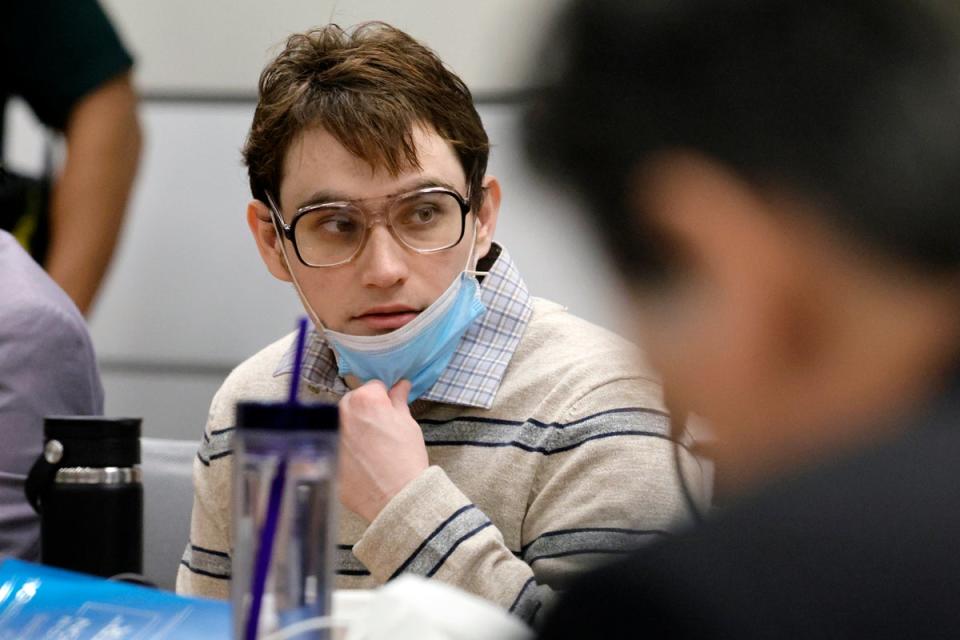
“And on July 4 2017, ‘I love to see the families suffer.’”
He told jurors that “every YouTube comment, every search, everything that’s in evidence you can review when you deliberate”, saying that “what one writes and what one says is a window into someone’s soul”.
Mr Satz said that Cruz’s comments and plans online were what he “wanted to do” and “what he did do”.
“What he wanted to do, what his plan was and what he did was to murder children at school and their caretakers,” he said.
“That’s what he wanted to do, that’s what he planned to do and that’s what he did.
“And he picked Valentine’s Day to do it.”
Pointing to both his online search history and his statements in jailhouse interviews with psychologists this year, Cruz researched other mass shootings for years in preparation for his own.
Footage previously shown in court showed the gunman describing how he began watching documentaries of the Columbine shooting when he was around 14 years old.
“We know he’s been thinking about it for a long time,” said Mr Satz.
“What do you do when you want to accomplish something? You research, you search.”
Cruz studied other mass shootings including the massacres at Virginia Tech and Charlottesville, he said.
Then he planned out the details, acquiring the items he needed – buying the AR-15 around a year before the shooting and then “accumulating a lot of bullets” and gun magazines and a vest to be able to carry all the magazines.
He also looked into past cases of how long it would take police to respond to a mass shooting and downloaded the bell schedule for the school to determine the best time to carry out his attack.
Mr Satz said Cruz worked out the time between when the gates would be unlocked for the end of school but students would not have left yet – so that
He even researched and planned to tell the Uber driver he was going to a music lesson so that they wouldn’t be suspicious of the large bag he was carrying laden with weapons, Mr Satz said.
Jurors also heard how Cruz looked into buying a guitar case to keep up this pretence and chose to wear his Marjory Stoneman JROTC shirt to blend in with other students.
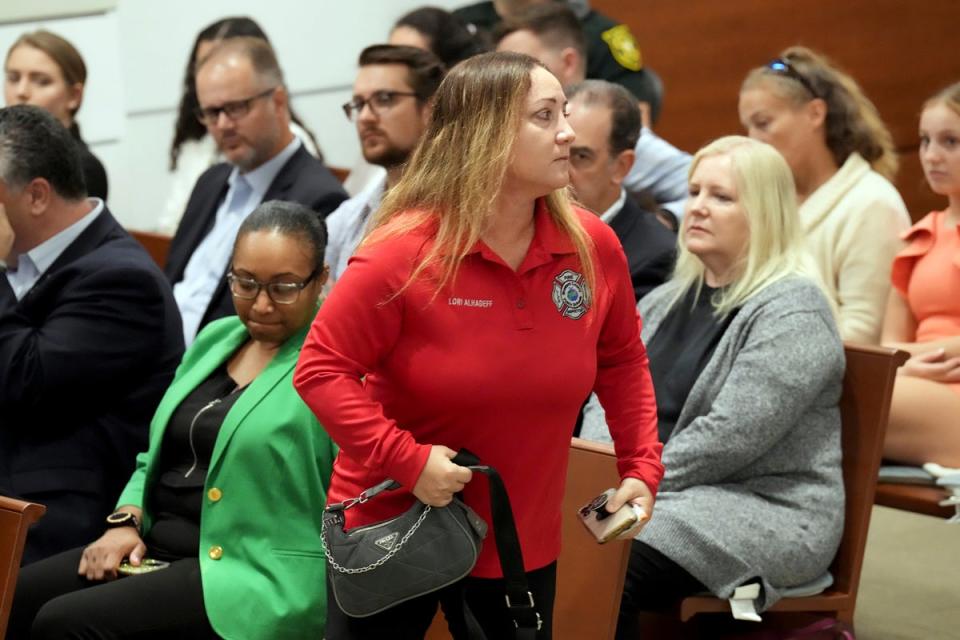
“All of these details he thought of and that’s exactly what he did,” said Mr Satz. “He did all this research and did all this thinking.”
Mr Satz walked jurors moment by moment through the shooting itself, from the killer coming face to face with student Chistopher McKenna in the east stairwell of the freshman building and telling him “you better get out”.
Family members of the victims wiped away tears as they once again heard the graphic details of each of their murders.
Cruz “was hunting his victims” as he stalked the freshman building, firing off 139 bullets in just seven minutes.
His first victims were Gina Montalto, Martin Duque Anguiano and Luke Hoyer who he shot in the first floor corridor.
After shooting into other classrooms on that floor and shooting athletic director Chris Hixon, he returned to the three students and opened fire on them a second time “to finish them off”.
Mr Satz revealed that two of Gina’s gunshot wounds were contact wounds, meaning that Cruz had the end of his AR-15 “right up against her chest and right up on her abdomen, right on her skin”.
The prosecutor reminded jurors of comments Cruz made online before the shooting, where he said “I don’t mind shooting a girl in the chest”.
“That’s exactly what he did to Gina Montalto,” he said.
The defendant fired 70 shots on the first floor and two shots on the west stairwell as he opened fire killing coach Aaron Feis, jurors heard.
When Cruz reached the second floor, students and staff were hiding in classrooms exercising the active shooter drills – after hearing the gunfire on the floor below.
“He fired six shots on the second floor as he couldn’t find any targets,” said Mr Satz.
On the third floor, students and staff hadn’t heard the gunfire on the first floor. Instead, dust from the gunfire had set the smoke alarms off, prompting people to evacuate their classrooms.
Hearing the shots fired on the second floor, students and staff tried to return to their classrooms just as the gunman continued up to the third floor.
Mr Satz told the graphic details of how Cruz shot and killed victims who didn’t make it into the classrooms in time.
He reminded jurors of Cruz’s own description of the moment he shot student Peter Wang in the head.
“His head blew up like a water balloon,” he quoted Cruz as saying, in footage from a March 2022 interview with a psychologist played in court during the rebuttal case.
In total, Cruz fired 61 rounds on the third floor – 139 rounds in total during his murderous rampage.
Mr Satz then detailed Cruz’s chilling behaviour in the aftermath of the shooting, as he blended in with the students and staff evacuating to leave the scene and went to a nearby Subway and McDonalds.
When he bumped into someone he knew, Mr Satz said he said “hi” and when asked about his college plans, told them he would be going “somewhere in Florida”.
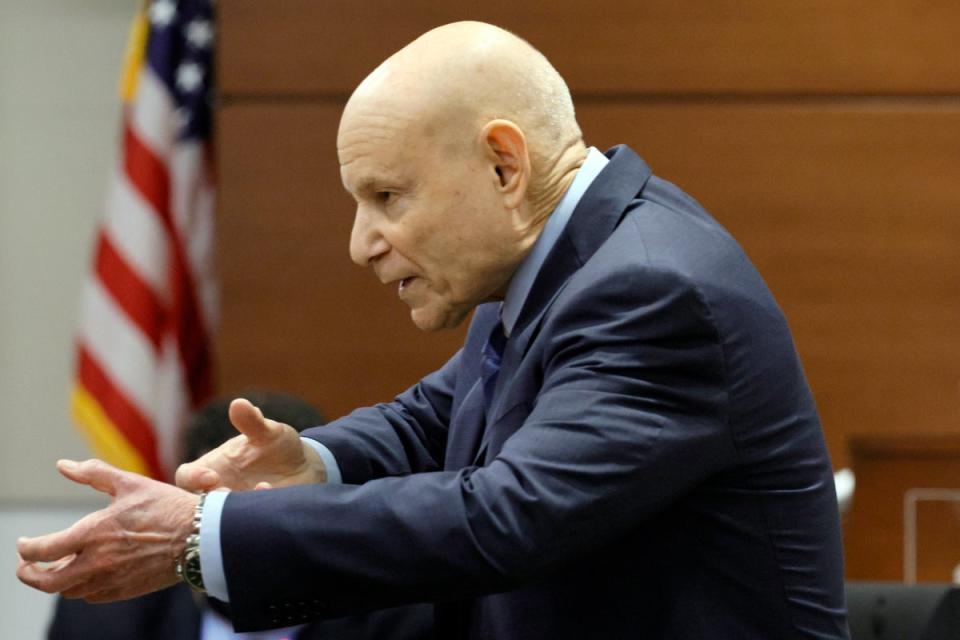
While family members sobbed in the gallery – with at least one relative leaving during the graphic details – Cruz was seen writing notes to his legal team.
“I just want you to see how tactical and purposeful his actions are,” said Mr Satz.
Jurors were also shown sensitive footage not released to the public.
The prosecutor walked through seven aggravating factors which he said are reasons that Cruz should be sentenced to death.
These are: that the defendant has been previously convicted of another capital felony or a felony involving the use or threat of violence to another person; the defendant knowingly created a great risk of death to many persons; the murders were especially heinous, atrocious or cruel; he murders were cold, calculated and premeditated; the murders were committed to disrupt or hinder a lawful government function – in this case, the running of a school; that a murder victinm was an appointed public official and that the murders were committed during the course of a burglary.
These seven aggravating factors together “outweigh any mitigation about anything about the defendant’s background or character,” Mr Satz said.
The prosecutor went on to pick holes in the mitigating factors which the defence is set to argue mean that Cruz’s life should be spared.
These included the claims that Cruz’s biological mother smoked, drank alcohol and abused drugs while pregnant.
Mr Satz said that the behaviour of Cruz’s biological mother “did not turn Nikolas Cruz into a mass murderer”. He also pointed to the state’s evidence that Cruz has antisocial personality disorder and can control his behaviour.
His disorders “certainly did not cause the defendant to abuse animals, to hate women, to have racist obsessions, or to cause him to murder 14 children and three of their caretakers,” he said.
“There is no brain damage. There’s damage to his personality and to his character, and hate is not a mental disorder… Those aggravating factors outweigh by a ton any mitigating circumstances.”
Mr Satz ended his closing argument by reading out the names of each of the 17 victims that Cruz murdered.
“For all of them, the appropriate sentence for Nikolas Cruz is the death penalty,” he said.
Defence: ‘Sentencing Nikolas to death will change absolutely nothing’
In the defence’s closing argument, Cruz’s attorney Melisa McNeill pleaded with jurors to show the mass shooter “mercy” by sparing his life when they deliver their verdict.
Ms McNeill tried to appeal to the jury’s “moral compass” on Tuesday, reminding them that each of them has an “individual” decision to make about whether he lives or dies.
“You have to live with your decision for the rest of your life,” she said. “It’s your individual moral decision.”
When they “wake up in the night” after the trial is over, she told they won’t be with their fellow jurors but they will be alone with “your heart, your moral compass”.
Ms McNeill said that killing Cruz will “change absolutely nothing” and will not bring back the 14 students and three educators that he murdered in one of the worst mass shootings in US history.
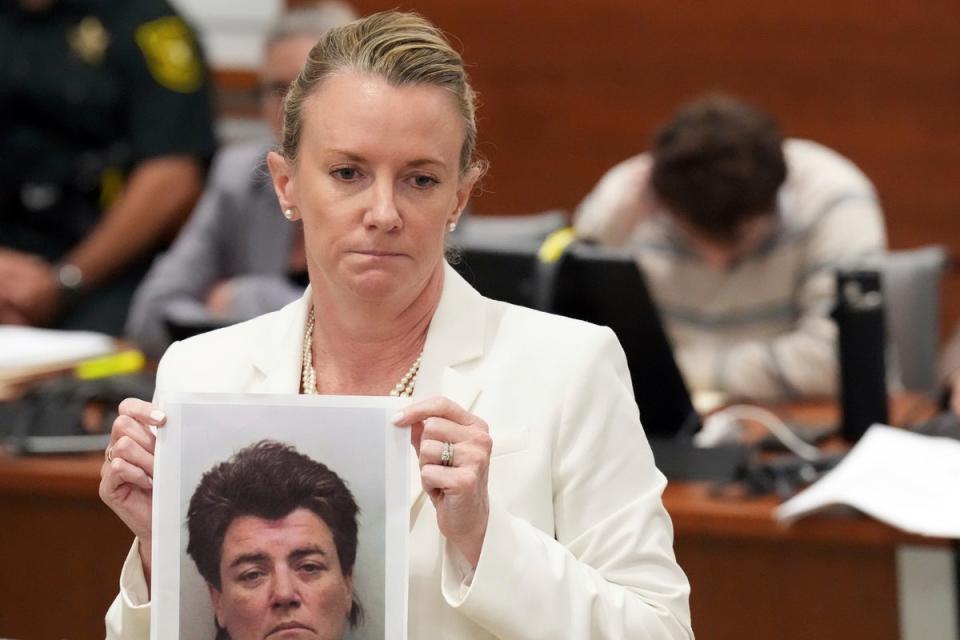
“Extinguishing his life will not make those problems go away. Sentencing Nikolas to death will change absolutely nothing,” she said. “It will not bring back those 17 innocent victims that he viciously murdered. It won’t.”
The defence attorney made a final attempt to convince jurors that Cruz has fetal alcohol spectrum disorder (FASD) from his biological mother’s abuse of alcohol while pregnant – and that this left him “mentally ill” and “brain damaged”.
“There is no time in our life that we are more vulnerable to the will and the whim of another human being than when we are growing and developing in the womb of our mothers,” she said.
“One would think it would be difficult for me and the other members of our team to present mitigation to come up here and ask you to sentence Nikolas to life without the possibility of parole. But it’s not because it is the right thing to do.”
She said that Cruz had “no control” over his birth mother Brenda Woodard’s actions while he was in the womb and so the mass shooter’s mental illness is “through no fault of his own”.
“You now know that Nikolas is a brain damaged, broken mentally ill person through no fault of his own,” she said.
Family members of some of Cruz’s victims were seen shaking their heads and raising their eyebrows in the public gallery as Ms McNeill made these comments.
The attorney pointed to defence witnesses Carolyn Deakins and Danielle Woodard who testified about Woodard’s abuse of alcohol while pregnant.
“She was on the drink, she was selling her body, she was smoking crack and she was drinking alcohol,” she said of Woodard.
She added: “There will be more Nikolas Cruzs as there will be more women that abuse alcohol when pregnant.”
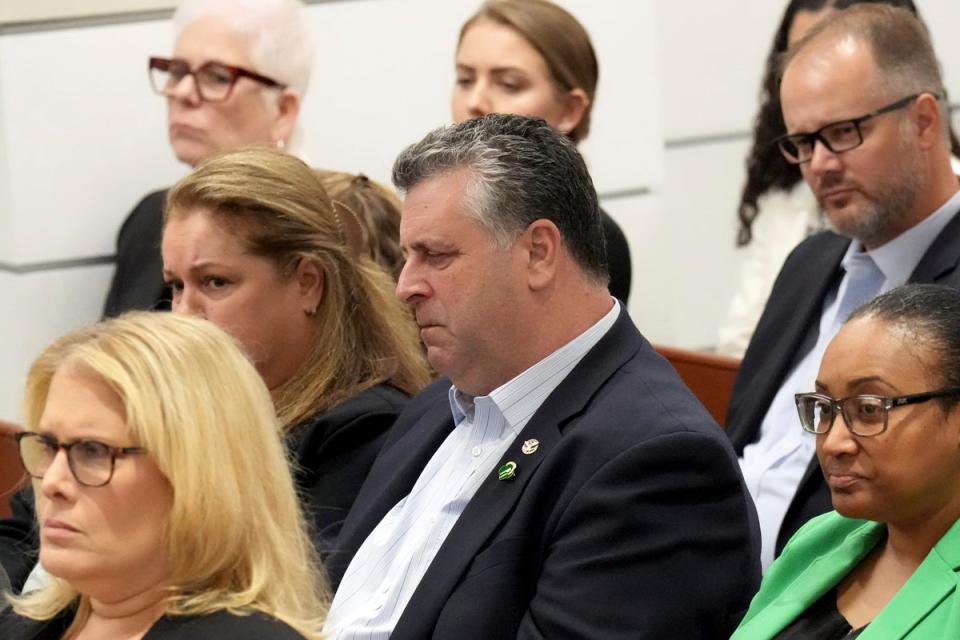
Ms McNeill outlined other mitigating factors such as Cruz’s behavioural problems in his early life and teenage years.
She told jurors he was “not like other children” but was “delayed socially, mentally, physically, cognitively, he struggled virtually in every area”.
Before his adoptive mother Lynda died, she said he was evaluated by four people for a Baker Act because he was cutting himself, drinking alcohol and there were concerns about him buying a gun.
Child and Family Services found that he was not in danger at his home, she said.
“The designation for him being a vulnerable, mentally ill adult did not go away,” she said.
“Three days later, Nikolas Cruz did exactly what that school social worker was so terrified of... he bought his first gun... literally days after being designated a vulnerable, mentally ill adult”.
The defence attorney went on to argue that a “civilised humane society” should not execute a mentally ill person and that jurors should sentence him to life in prison.
“He was doomed from the womb and in a civilised humane society do we kill brain damaged mentally ill broken people? Do we?” she asked.
“Punishment without understanding is not justice,” she said.
“We can give mercy to the very people that deserve it the least. Mercy is not earned or deserved. It is bestowed on someone.”
“Mercy is what makes us civilised. Mercy is what puts an end to violence. Giving mercy to Nikolas will say more about who you are than it will ever say about him.”
She also took aim at the prosecution for their case, saying that they had “done everything they can to dehumanise Nikolas Jacob Cruz”.
“They don’t even say his name,” she said.
She questioned whether jurors needed to see graphic footage of the shooting again in the state’s closing.
“Did you really need to see that 14 minute video again… You don’t need to look at those photos again. You don’t need to hear those gunshots again. You don’t need to see that 14 minute video,” she said.
“The state of Florida wants to put you in a place of hate and anger and vengeance. As if that’s where you’re at you’re more likely to sentence that man to death.”
She urged jurors not to make their decision on “passion, emotion and anger”.
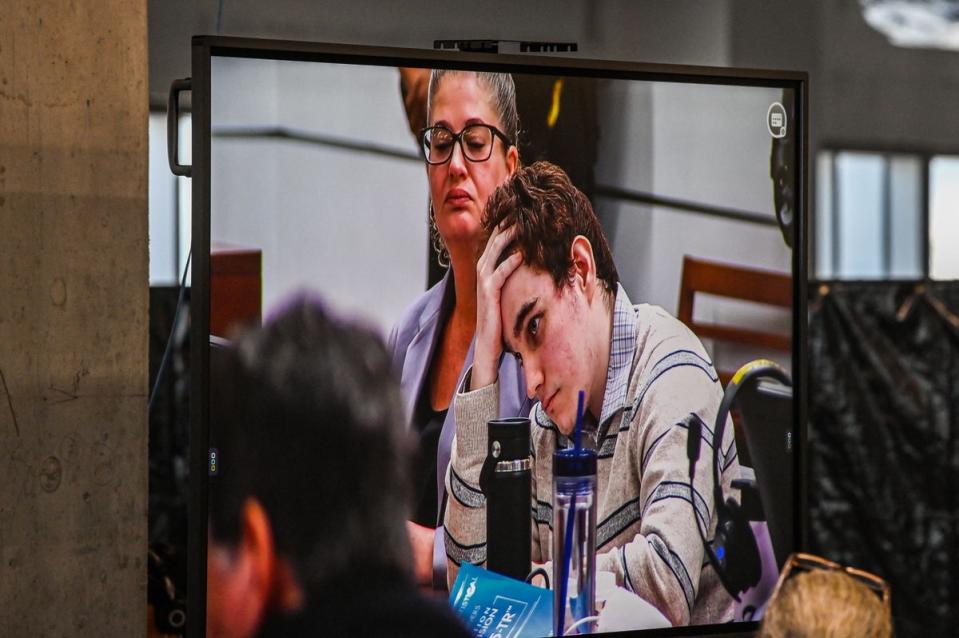
“At some point we have to realise that brain damaged and mentally ill people are not going anywhere. And we cannot ignore them or disregard them,” she said.
“To take a life when a life has been lost is revenge not justice.”
She concluded the closing argument by telling jurors that Cruz’s “damage” is a mitigating factor which means his life should be spared.
“We are not here to suggest that you do not punish Nikolas Cruz. We are asking that you take into consideration his damage when you make that decision. And that you consider mitigation,” she said.
“As you listened to the testimony over these past couple of months, are there things about Nikolas’s life that you wished hadn’t happened? Are there things about Nikolas’s life that didn’t happen that you wished happened? Are there things that he didn’t get that you wish he’d gotten? Was he missing people in his life that you wish you hadn’t missed?”
“I suspect you would answer yes to each of those questions, and every time you do, that’s mitigation. That’s a reason for life.”
She added: “Sentencing Nikolas Cruz to life is the right thing to do. So I now put in your hands his life.”

